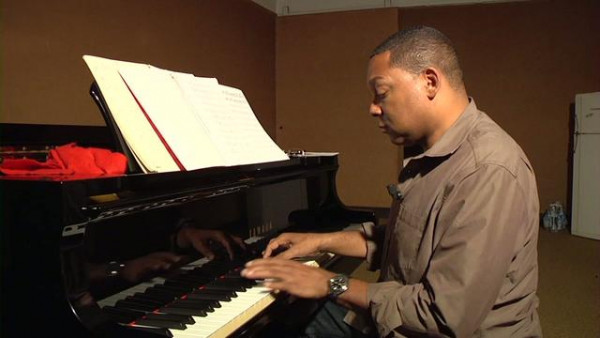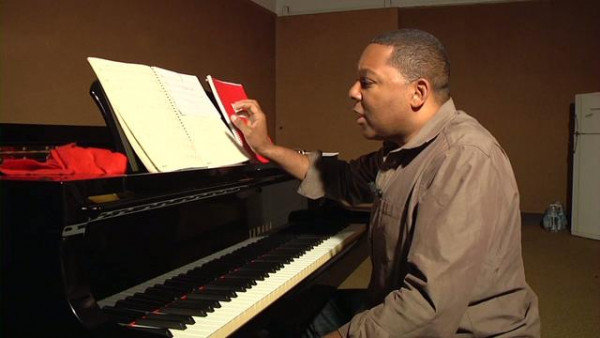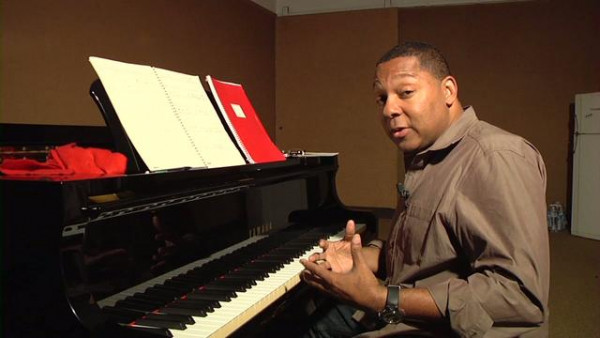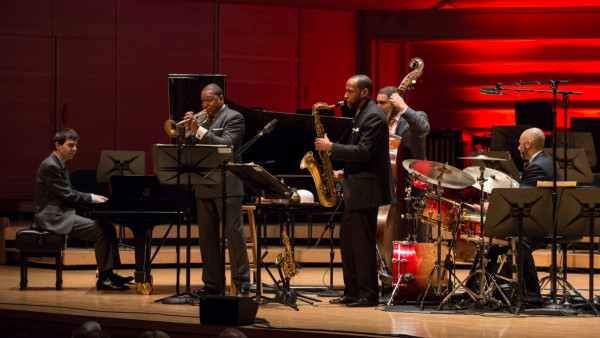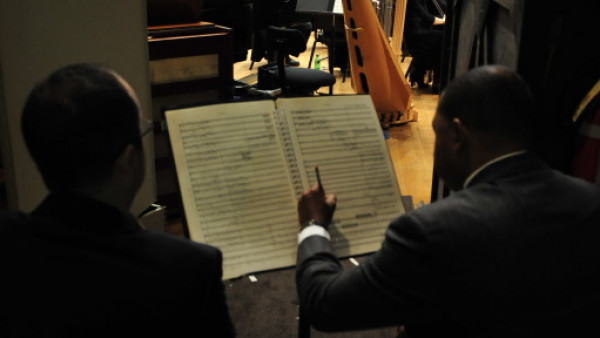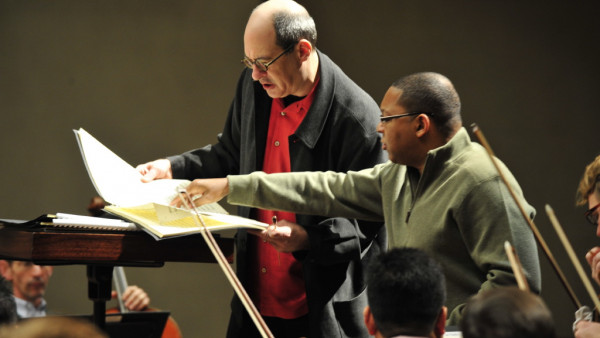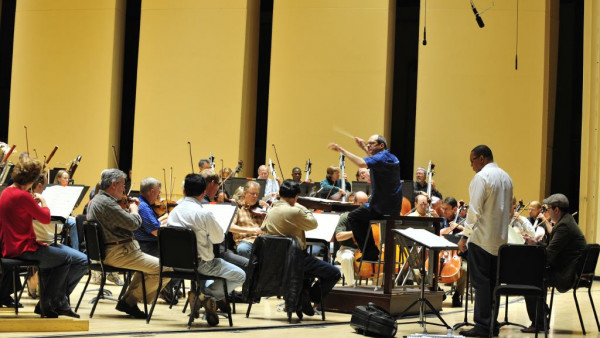The making of Blues Symphony
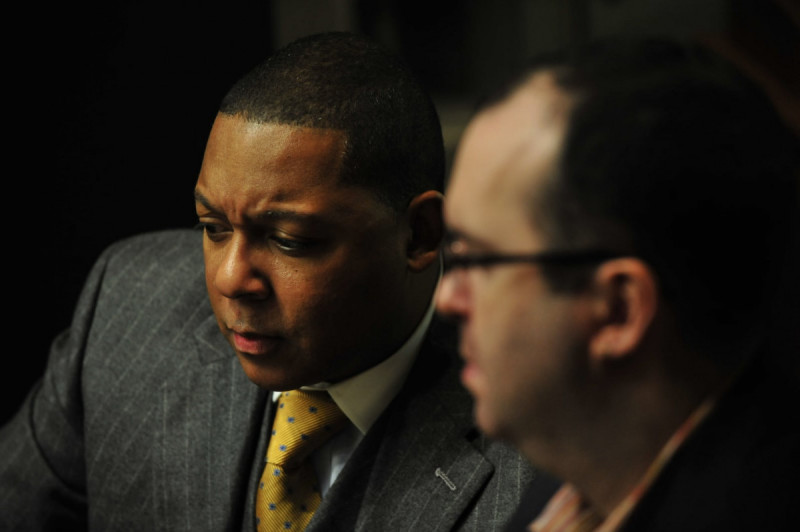
Wynton Marsalis and Jonathan Kelly (photo: Frank Stewart)
When we were working on All Rise in 1999, Jonathan Kelly came to my house as a young kid to pick up music. He said he was a bass player. We were working on All Rise and copyists all over New York were being worn out. In desperation I asked him, ”Do you know how to copy music?” He lied and said, “Yeah.” That started our years of working together. To say I love him is an insult. He is honest, very accurate, dedicated and down-home (from Maine). I write in a crazy homespun way with instrumentation instructions all over the place. On some pages, JK is the only one who could possibly understand what I’ve indicated. We also work on symphonic pieces across years as if it were a hobby because, thank the Good Lord, there has always been constant and unending overwork in our day jobs. Down through the decades we have stayed up through years of nights going over details and making changes to all kinds of music, but to this one in particular. He has gone down that long road with me on Blues Symphony and on so many pieces that have had a limited listenership and also many that have never been released or even recorded. We joke (after a week of sleepless nights) about working with a desperation that is only accorded the “under-appreciated” shall we say. Here are some of his observations on the Blues Symphony experience.
- Wynton
Red Pencils and Faith
As a music copyist, some pieces of music arrive on my desk like an uncut gem, just needing to be massaged and polished. This one, however, was like digging for gold. There was an unsecured promise that there may be 7 pieces of gold SOMEwhere across the country and we were going to have to grab our sifting pans and pack a knapsack full of faith. But how else would you write a Blues Symphony? Get your pail and start digging.
Back in 2008, I was vaguely aware that Wynton had been commissioned to write a piece for the Atlanta Symphony Orchestra (ASO). I was, however, completely UNaware that we’d still be working on it in 2020. For the sake of perspective, in the time it took to finish Blues Symphony, Wynton and I worked on and completed 2 other symphonies, a violin concerto, several ballets, dozens of recordings and literally hundreds of pieces for the Jazz at Lincoln Center Orchestra. But always, Blues Symphony found its way back into my orbit.
If the ASO was expecting a 30-minute piece—we gave them 60. They expected it in June, we delivered it in November, merely a week or so before rehearsals began. I was 32 years old and about to get a stark lesson on my own inadequacies—Wynton was, ahem, older, but he was about to be schooled as well. We sat at a table in front of the orchestra each armed with a full score as Maestro Robert Spano’s baton spurred the ASO onward. To describe the sounds we heard would be too graphic for public consumption, but the truth could be found in our reactions. I thumbed through score page after score page trying (hoping, actually) to quickly locate a technical error—maybe the computer had caused a glitch or perhaps I had transposed an instrument incorrectly. I was trying to find ANYthing that would make the cacophony we were hearing make sense. Wynton, on the other hand, veered away from his score and looked slightly unaffected. He began to whisper to me, covering his mouth in the way that football coaches do when they are afraid that the other team might be reading their lips. “Man, is this THEM or is it ME?” I replied, “It can’t ALL be them”.
Thus began a fireworks display of edits. “Cut from measures 32-55…Take out the English Horn at letter B…actually leave the English Horn, but take out the Clarinets….More Timpani…Scratch that, LESS Timpani”. You get the idea.
The rehearsals were exhausting, but the conversations back at the hotel were the actual grind. Two grown men, both on the same sinking ship and neither can swim. But each are trying to explain to the other HOW they think swimming works. We attacked the scores with red pencils as we would at various times in for much of the next decade.
For the performance, we wanted to watch from somewhere that we could still look at and edit the scores without being a distraction to the audience. We were directed to a small, out of the way sort-of-room that overlooked the stage. It’s normal occupant, a single camera operator, welcomed two more people to his quarters in good cheer. The three of us could barely fit, and strained one-at-a-time to peek through the narrow window.
I’m not sure if the camera man could sense my stress or whether he just wanted someone to share the blame for what was coming from the stage but, he tapped my knee with a flask and I graciously obliged. Southern hospitality. Well, eventually the show finished, the audience clapped, the ASO were very courteous, Wynton got some flowers, but everyone in that room had the same feeling: “Jazz Man Bites Off More Than He Can Chew”. Jazz is one thing because “you can make up all those notes”, but the orchestral tradition, well, that was another beast.
Blues Symphony got put back into a box, placed on a shelf somewhere left to sit alone in a puddle of its own short-comings. Wynton and I moved on to other, more successful projects. The Abyssinian Mass came and went to much acclaim. “Yeah, but what about that Blues Symphony, though?” The next big orchestral project we tackled faired much better. Writing Swing Symphony wasn’t without its hurdles, but having the jazz band WITH the orchestra solves a lot of the orchestration obstacles that plagued Blues Symphony. Without taking too deep a dive into music orchestration, the main challenge is how to coax the feeling and aesthetics of jazz and blues music out of orchestras who, for the most part, spend their lives practicing and performing European concert music. Beyond that, the lack of attempts by composers to merge the two means you don’t have the benefit of learning from others’ mistakes. No disrespect intended to our kin in the orchestral world, but the pedagogical approach of most conservatories results in graduates who have barely ever heard ragtime music, much less performed it. In order to quell any offense, it should be noted that most jazz schools are equally inept at exposing students to the full range of Western music, as well.
A few years passed but then an opportunity finally presented itself. The American Composers Orchestra in New York reached out and asked if the piece ever got completed. It hadn’t been completed, but I may have glossed over that in agreeing to present the piece as a part of their Spring 2015 season. But before that, we needed another opportunity to workshop the piece. The Shenandoah Conservatory offered their services and Wynton and I sharpened the red pencils once again. We made 4 or 5 trips to hear the students play all the various iterations of Wynton’s notions for improvement. On the first car trip down to Virginia, Wynton very seriously said to me, “If this piece still sounds sad, I’m giving this up.” Meaning—no more writing for symphony orchestras.
It still sounded sad…..BUT…..it sounded a little better. And beyond the improvement in the piece, there was something more spiritual to it.
I can’t speak for Wynton but working with all these students was really uplifting. I remember sitting in the courtyard of the university with the principal percussionist, surrounded by dozens of pages of sheet music and me asking him for advice and him responding very politely and respectfully. I told the young man, “listen, I don’t know how to notate for the percussion—tell me what I’m doing wrong, stop being coy”. Pandora’s box was opened and he proceeded to point out instance after instance of my own sophomoric understanding of the percussion section. I also remember Wynton playing examples of Bessie Smith and Robert Johnson on his iPhone at the front of the stage during a rehearsal—all 100+ kids squinting their eyes trying to hear what he was playing. It occurred to me in that moment, these students WANT to play this music. Perhaps, the inability of American orchestras to authentically interpret American music isn’t necessarily because of a lack of effort or interest, but rather a lack of exposure. Onward, we must go.
More time passed, more notes were written, “Yeah, but what about that Blues Symphony, though?” We were with the Philadelphia Orchestra in 2017, for the recording of Wynton’s “Concerto in D for Violin and Orchestra” and the administration asked if Wynton had any other pieces for orchestra that they may be able to present. “Well, funny you should ask….”. Cue the red pencils. We edited the piece, then edited some more. Maestro Cristian Macelaru had worked with us on the concerto, so he was well prepared for the deluge of changes, edits, suggestions, etc. that predictably did come. Luckily, the Philadelphia Orchestra also has an ace staff of music librarians who LITERALLY were editing the parts even after the first two concerts had ended.
So here we are.
This recording is the culmination of the talents, efforts, well-wishes, disparagements (oh, I didn’t mention those, but there were plenty), advisements, critiques, and prayers of quite literally 1000s of people. And that’s how you make a Blues Symphony. You sit alone and wallow. You wail to those that will listen. You seek help and you find it. You admit your own inadequacies. The ones you can change, you do. The ones you can’t, you embrace. You search high and low for answers, but mostly you find more questions. But most importantly, you never quit. The spirit of America lives in the Blues. It’s our language. It talks of our scars and it talks about healing. It laments the past and yearns for a brighter future. “Yeah, what about that Blues Symphony, though?”
- Jonathan Kelly

